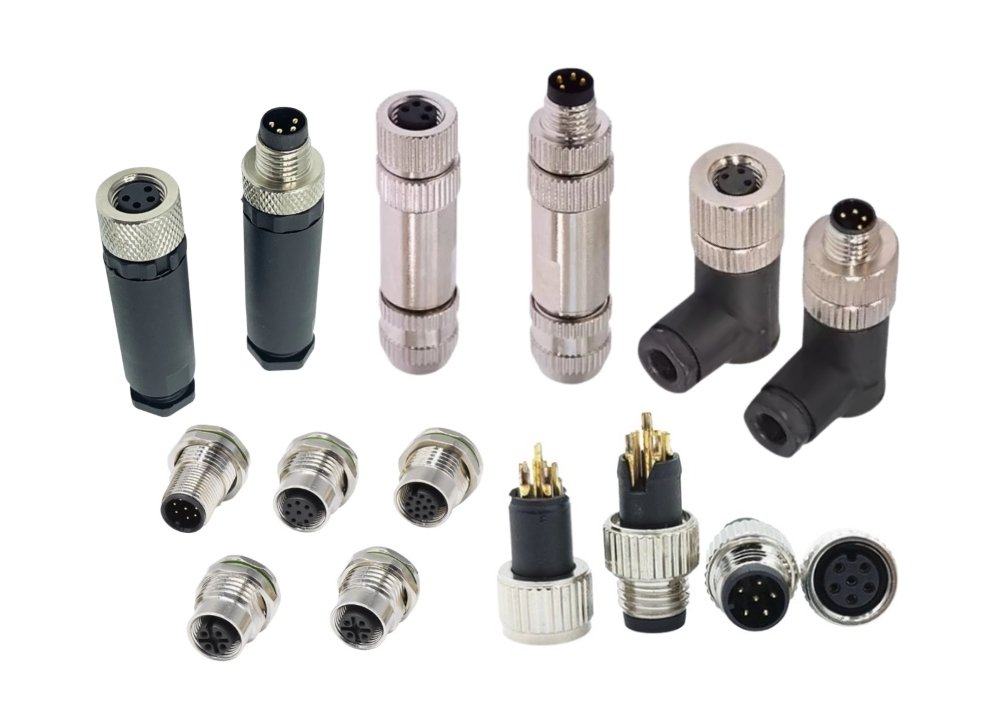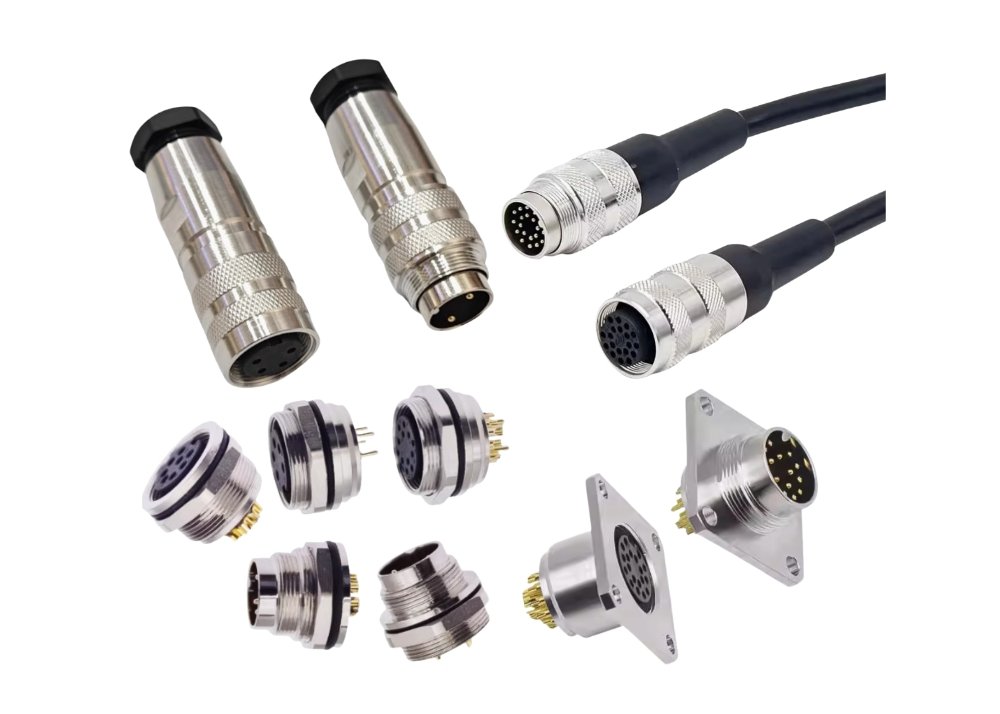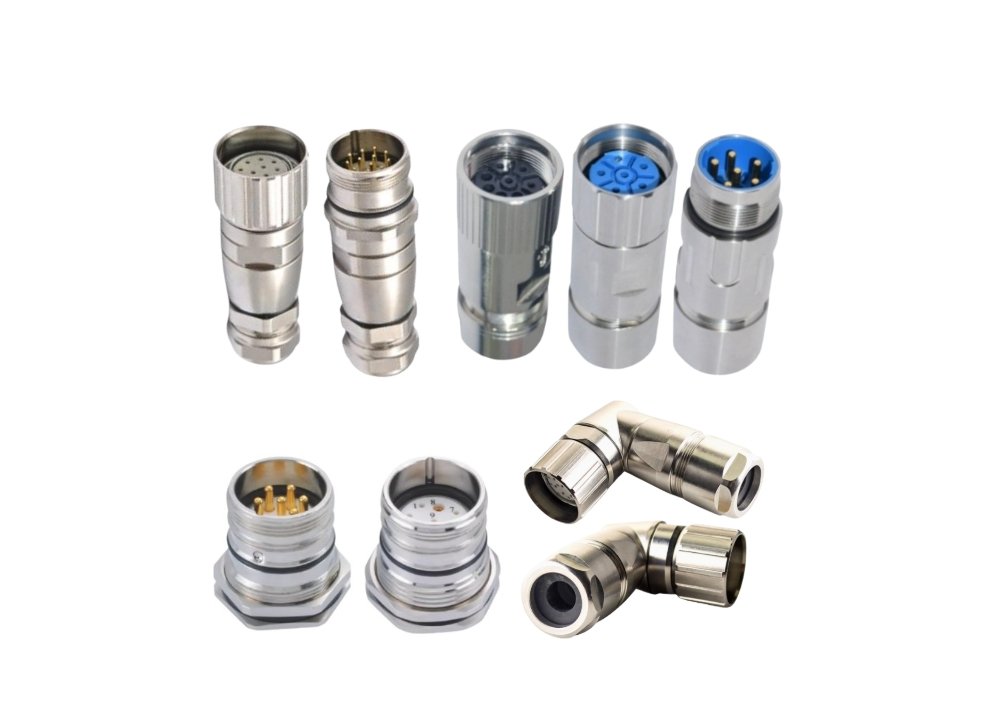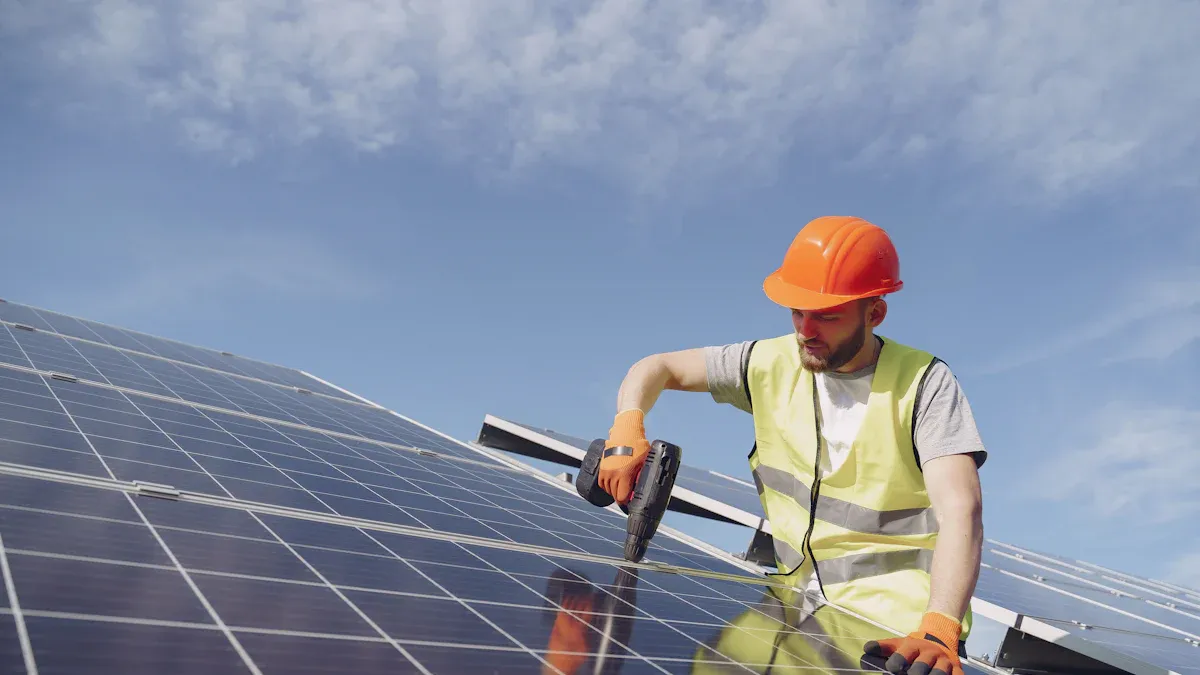
You can transform your solar energy project with the latest solar connectors designed for industrial use. When you choose advanced connector solutions such as the M8 connector or Type B connector, you gain faster connection and improved reliability.
- The SOLARLOK 2.0 connector from a leading connector factory cuts installation time to just 30 seconds, which means an 80% reduction compared to older designs.
- Modern connectors deliver 98-99% energy transfer efficiency and reduce downtime by 95%.
- Safety features like secure locking and arc-fault prevention lower electrical hazard risk by 90%.
These innovations let you build smarter and more resilient solar energy systems.
The Role of Solar Connectors in Industrial Photovoltaic Installations
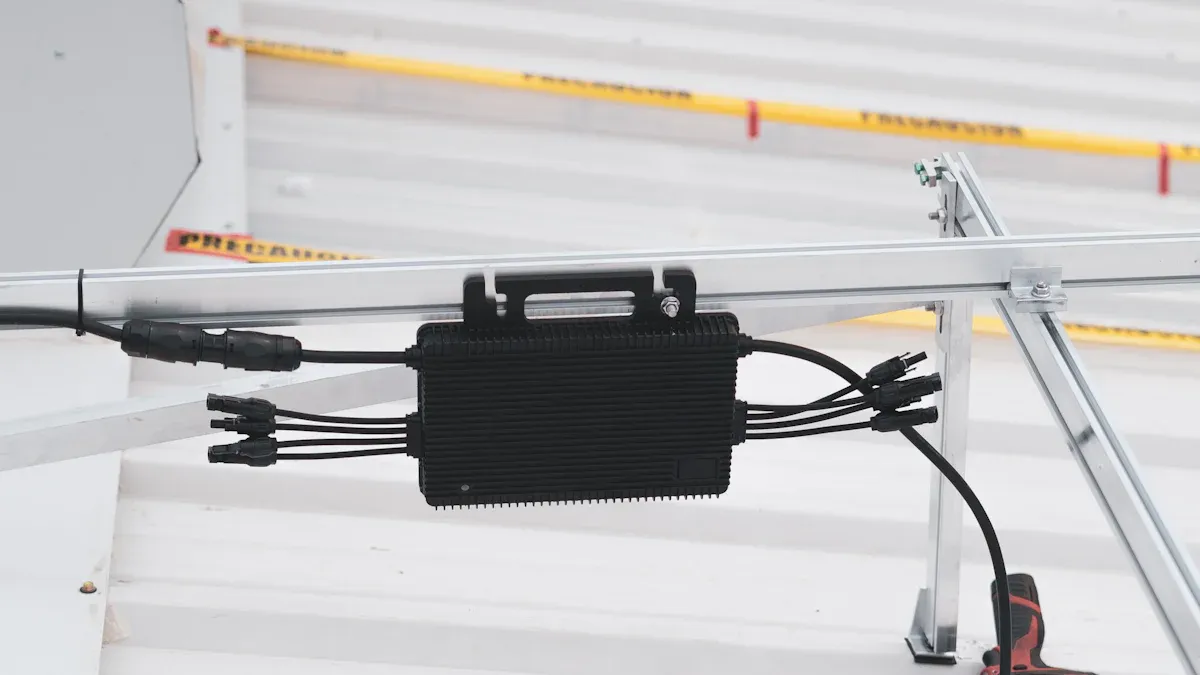
Importance of Reliable Solar Connectors
Impact on System Performance
You rely on solar connectors to maintain the efficiency and reliability of your industrial photovoltaic installations. These connectors serve as the backbone of your system, ensuring robust and durable connections that keep your solar power capacity at peak performance. Recent industry reports highlight that connectors must withstand harsh environments, especially in sectors like manufacturing, mining, and agriculture. When you use high-quality pv connectors, you minimize energy loss and reduce the risk of system failures. Utility-scale projects demand connectors that handle high voltage and current, which is essential for safe and efficient electricity transmission.
Note: Wiring and connectors are the number one reason for solar project failures. You can address these challenges by selecting connectors that meet strict standards and by performing regular inspections.
Safety Considerations
Reliable solar panel connectors play a critical role in protecting your investment and ensuring safety. If you use substandard connectors, you increase the risk of fires and urgent safety issues. For example, SolarGrade inspections found that 40% of urgent safety issues stem from connector problems. With nearly 3.5 billion PV connections worldwide, the scale of potential issues is significant. You can reduce hazards by choosing connectors with high IP ratings, such as IP65 or IP68, which offer excellent weather resistance. Regular maintenance and adherence to compliance requirements further enhance safety and system integrity.
- Reliable connectors ensure efficient power transfer and reduce energy loss.
- High-quality connectors withstand harsh environmental conditions.
- Certified connectors and regular inspections lower maintenance costs.
- Modern pv connectors handle high voltages and currents effectively.
- Proper tools and risk assessment improve safety and reliability.
Growth of Industrial Photovoltaic Installations
Market Trends in Solar Adoption
The global market for photovoltaics continues to expand rapidly. You see this growth reflected in the rising installed capacity and the increasing share of electricity generated from solar energy. The table below shows recent global statistics:
| Year | Global Installed Capacity (GW) | Percentage of Global Electricity Demand | New Capacity Added by China (%) |
|---|---|---|---|
| 2022 | 1,185 | 6% | N/A |
| 2023 | 413 (estimate) | N/A | 60% |
| 2019 | N/A | 3% | N/A |
This surge in solar power capacity demonstrates the growing importance of reliable connectors in large-scale projects.
Increasing Demands on Solar Connector Technology
As industrial photovoltaic installations grow, you face increasing demands on connector technology. The expansion of the solar industry drives a 20% rise in demand for advanced pv connectors over the next five years. Emerging markets, especially in Asia-Pacific, now account for 45% of the global share as investments in solar infrastructure increase. Government policies that focus on renewable energy and compliance with international standards further boost the need for efficient and high-quality connectors. Manufacturers continue to innovate, offering connectors that support optimal energy transfer and meet the evolving requirements of modern solar systems. Your choice of connector directly impacts the performance, safety, and longevity of your photovoltaic installations.
Overview of Common Solar Connector Types
MC4 and Other Standard Solar Connectors
Features and Limitations of MC4
You encounter MC4 connectors in nearly every industrial photovoltaic installation. MC4 has become the industry standard because it offers high efficiency and reliability. When you use an MC4 connector, you benefit from a plug-and-play design that simplifies installation. The built-in locking system prevents accidental disconnections, which helps you maintain safety and system integrity. MC4 connectors handle up to 30A of current and 1000V of voltage, making them suitable for large-scale solar projects. Their IP67 rating protects against dust and moisture, so you can install them in harsh environments without concern for electrical faults.
MC4 connectors use materials that resist high temperatures and UV radiation. This durability ensures long-term performance, even when exposed to direct sunlight. You also notice that MC4 connectors are affordable and widely available, which makes them a cost-effective choice for your projects. However, MC4 connectors require proper crimping tools for installation, and you must follow manufacturer guidelines to avoid connection errors.
MC3 connectors still hold a notable market presence, but you see MC4 replacing MC3 in most new installations. MC3 connectors lack the advanced locking mechanism found in MC4, which can lead to accidental disconnects. T4 connectors are emerging in specific regions, offering high performance and adaptability to various environmental conditions.
Tip: Always verify compatibility between connectors and cables before installation to prevent system failures.
Recent Improvements in Standard Connectors
You benefit from recent advancements in MC4 connector technology. Manufacturers have improved weather resistance, so you can rely on MC4 connectors in extreme climates. Enhanced UV protection and better sealing materials extend the lifespan of your solar connections. Some MC4 connectors now feature tool-free installation options, which reduce labor time and minimize errors.
The table below compares MC4 connectors with other standard solar connector types:
| Feature | MC4 Connectors | Other Connectors (e.g., XT60, Anderson Powerpole) |
|---|---|---|
| Durability | High | Varies |
| Ease of Use | Plug-and-play design | XT60 is user-friendly but lacks locking mechanism |
| Safety Features | Built-in locking system | Often absent in other connectors |
| Compatibility | Industry standard | Less standardized, may need adapters |
| Current Handling | Up to 30A | XT60 is for low-power applications |
| Voltage Handling | Up to 1000V | Varies |
| Cost-effectiveness | Affordable and widely available | Higher cost for some alternatives |
| Weather Resistance | IP67 rating for dust and water | Varies |
You see MC4 connectors outperform other options in durability, safety, and compatibility. MC3 connectors, while still used, do not match the reliability of MC4. T4 connectors offer high adaptability, but MC4 remains the preferred choice for most industrial applications.
- MC4 connectors are designed for high durability and reliability in solar systems.
- They feature a locking mechanism that prevents accidental disconnections.
- With an IP67 rating, they are resistant to dust and moisture, reducing electrical fault risks.
- Made from materials that withstand high temperatures and UV radiation, ensuring long-term performance.
- Their widespread use in various solar installations demonstrates their effectiveness and reliability.
Specialized Industrial Solar Connector Types
High-Current and High-Voltage Solutions (e.g., SOLARLOK, RADSOK Helios H4)
You face unique challenges in industrial solar projects that require connectors capable of handling higher currents and voltages. Specialized solar connector types, such as SOLARLOK and RADSOK Helios H4, provide robust solutions for these demands. Heavy-duty connectors feature aluminum or thermoplastic covers, which protect against harsh environments. You can use these connectors in off-grid systems with current ratings from 10A to 80A and protection ratings up to IP69k.
| Connector Type | Features | Current Rating | Protection Rating |
|---|---|---|---|
| Heavy Duty Connectors | Robust design for harsh environments, aluminum or thermoplastic covers | 10A to 80A | IP65 to IP69k |
You find these connectors compatible with MC4 in appearance and function. They offer enhanced temperature tolerance up to 120°C and require tools for unlocking, which adds security. IP68-rated connectors provide complete environmental protection, making them ideal for utility-scale installations.
In addition to MC4 and Tyco Solarlok connectors, you can choose Amphenol H4, SMA, and TUV connectors for high-current and high-voltage applications. Each connector type offers unique features that help you meet the demands of industrial solar systems.
Modular and Customizable Connector Designs
You can optimize your solar installations by selecting modular and customizable connector designs. These connectors allow you to adapt to different system configurations and expand capacity as needed. Modular connectors simplify maintenance and upgrades, so you can future-proof your investment. Customizable options let you match connector specifications to your project’s requirements, ensuring reliable performance and safety.
Note: Modular connectors support scalability and flexibility, which are essential for large-scale industrial photovoltaic installations.
Innovations in Solar Connector Technology
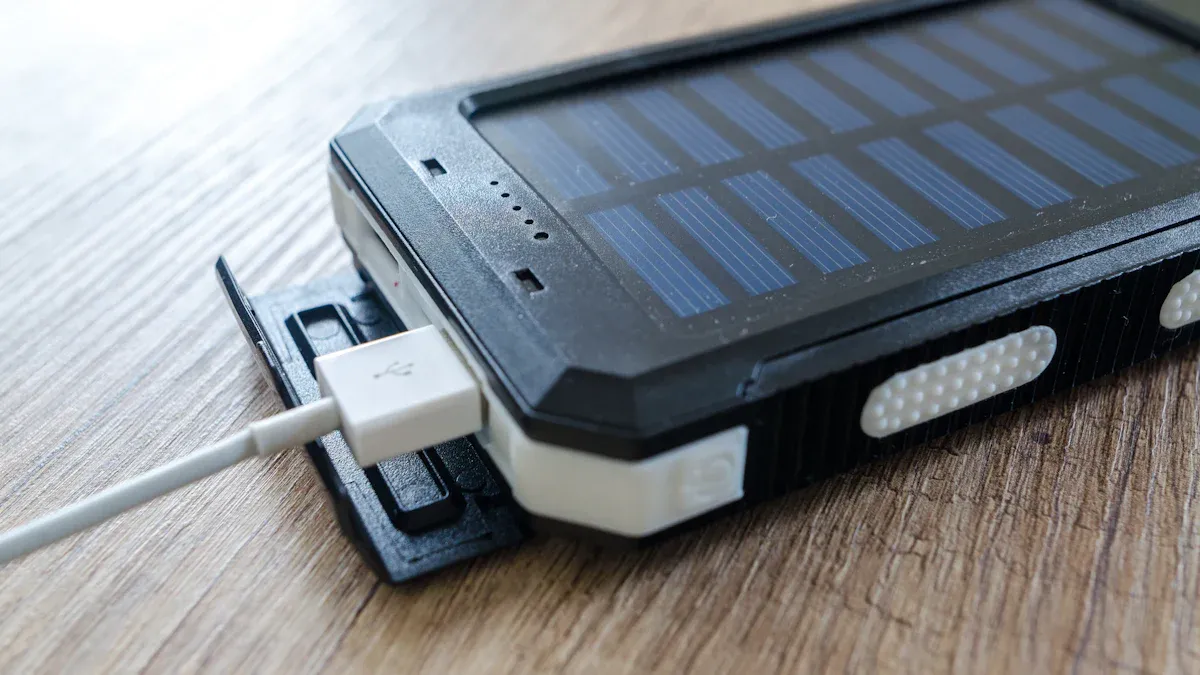
Advanced Materials for Solar Connectors
Enhanced Durability with Weatherproof Construction
You see a major shift in the durability of solar connectors as manufacturers introduce advanced materials and weatherproof design features. Gel-filled connectors now provide essential moisture resistance, especially for underground installations where exposure to water can compromise performance. Connectors made from corrosion-resistant metals extend the lifespan of your system, even in harsh industrial environments. Built-in strain relief features protect wires from mechanical stress, which improves overall durability and reduces the risk of connection failures.
- Gel-filled connectors offer moisture protection for underground use.
- Corrosion-resistant metals increase longevity in tough conditions.
- Strain relief features safeguard wires against mechanical stress.
When you select connectors with weatherproof construction, you ensure that your solar panel connectors withstand extreme temperatures, heavy rainfall, and dust storms. This reliability is crucial for industrial photovoltaics, where downtime can lead to significant losses. You benefit from a weatherproof design that meets UL standards, guaranteeing a UL rated connection for your solar energy system.
Improved Weather and UV Resistance
You demand connectors that resist weather and UV damage over years of operation. Manufacturers now use high-grade polymers and advanced coatings to shield connectors from sunlight and environmental hazards. MC4 connectors and MC3 connectors feature materials that prevent degradation from UV exposure, which is vital for installations in open fields or rooftops. Weatherproof connectors maintain their integrity in fluctuating temperatures, ensuring stable performance throughout the year.
Tip: Choose connectors with proven UV resistance to avoid premature aging and costly replacements.
You notice that pv connectors with weatherproof ratings such as IP67 or IP68 deliver consistent results in industrial settings. These connectors keep moisture and dust out, protecting the electrical connection and supporting long-term reliability.
Smart and Intelligent Solar Connectors
Integrated Monitoring and Data Capabilities
You can now leverage smart solar connectors to monitor system health and optimize performance. Integrated sensors track voltage, current, and temperature at each connection point. This real-time data helps you identify inefficiencies and prevent failures before they occur. Advanced MC4 connectors support data communication, allowing you to connect your solar array to monitoring platforms for instant analysis.
- Integrated sensors provide real-time system data.
- Smart connectors enable predictive maintenance and faster troubleshooting.
- Data capabilities help you maximize energy output and reduce downtime.
You gain a competitive edge by using intelligent connectors that support remote diagnostics and system optimization. These features are essential for large-scale industrial installations, where manual inspections are time-consuming and costly.
Automated Fault Detection Features
You rely on automated fault detection to maintain safety and efficiency. Smart connectors use built-in algorithms to detect arc faults, overheating, or abnormal current flow. When a fault occurs, the system alerts you immediately, allowing for quick intervention. MC4 connectors with intelligent fault detection reduce the risk of fires and electrical hazards, which protects your investment and ensures compliance with safety standards.
Note: Automated fault detection minimizes downtime and enhances the reliability of your solar energy system.
You see these features becoming standard in new pv connectors, especially in utility-scale projects where safety and uptime are critical.
Tool-Free and Fast Installation Solar Connector Types
Push-Fit and Snap-In Mechanisms
You streamline your installation process with tool-free solar connector designs. Push-fit and snap-in mechanisms eliminate the need for specialized tools, making assembly faster and more intuitive. Tool-free rail attachments allow you to secure solar panels without wrenches or screwdrivers, which speeds up installation and reduces labor costs.
- Tool-free rail attachment enables quick panel assembly.
- Adjustable telescopic rails minimize on-site cutting and waste.
- Rapid installation times improve project efficiency.
You benefit from enhanced installation accuracy, as fewer manual steps reduce the chance of human error. Simplified designs also make it easier to train new crew members, lowering initial training costs and improving overall productivity.
Reducing Labor and Installation Time
You achieve significant savings in labor and time by choosing connectors with crimping-free installation. The latest MC4 connector designs eliminate the need for crimping tools, which simplifies the process and ensures stable connections. On-site labor costs and installation time drop by up to 40% due to the plug-and-play nature of these connectors.
- Crimping-free installation streamlines the process.
- Time savings of up to 40% boost project profitability.
- Improved reliability reduces risks associated with traditional crimping.
You see these innovations reflected in the growing adoption of MC4 and MC3 connectors for industrial projects. Fast installation and reliable connection quality help you meet tight deadlines and maintain high standards for safety and performance.
Callout: Tool-free connectors not only save time but also enhance the quality of your installations, reducing the risk of costly errors.
Addressing Industry Challenges with Solar Connectors
Durability and Longevity in Photovoltaic Installations
Corrosion Resistance Technologies
You need connectors that withstand harsh environments and deliver long-term performance. Modern pv connectors use advanced corrosion-resistant metals and coatings. These materials protect against rust and chemical exposure, which is common in industrial settings. When you select connectors with these features, you reduce maintenance needs and extend the lifespan of your photovoltaic installations. Manufacturers design mc4 and mc3 connectors with anti-stripping bolts, which further improve durability and ensure a secure connection over time.
UV and Environmental Protection Solutions
Industrial solar arrays face constant exposure to sunlight, rain, and dust. You benefit from connectors that use weatherproof construction and UV-resistant polymers. These materials prevent cracking and degradation, even after years of outdoor use. Weatherproof mc4 connectors meet ul and safety standards, so you can trust their performance in extreme conditions. By choosing connectors with these protections, you maintain system quality and reduce the risk of costly failures.
Tip: Always verify that your connectors meet solar array compliance and environmental standards for maximum reliability.
Safety Enhancements in Solar Connector Types
Arc-Fault Prevention Mechanisms
You must prioritize safety in every solar installation. The latest connector designs, such as the EL6 Connector, include a dulling mechanism that prevents electrical arcing. This feature protects your system from fires and extends the life of both the connector and connected devices. Mc4 connectors also support arc-fault prevention, which is essential for meeting safety standards in industrial environments.
Secure Locking and Anti-Disconnect Features
Accidental disconnections can lead to downtime and safety hazards. You can rely on connectors with double locking mechanisms, like the EL6, which combine an angle lock and a pull-out lock for a secure connection. The anti-stripping design of bolts adds another layer of durability. These features make mc4 and mc3 connectors ideal for high-performance applications where safety and reliability matter most.
- Double locking mechanisms reduce accidental disconnects.
- Anti-stripping bolts increase connector lifespan.
- Secure connections help you meet compliance requirements.
Scalability and Flexibility for Large-Scale Photovoltaic Installations
Adaptability to Utility-Scale Projects
As your solar projects grow, you need connectors that support scalability. 1500V connectors allow you to connect multiple panels in series, which is vital for building large solar farms. Their high voltage rating ensures you do not lose efficiency, even in extensive solar arrays. Mc4 connectors offer maximum compatibility with various wire gauges, making them suitable for both new installations and upgrades.
Compatibility with Diverse PV Modules
You often work with different types of pv modules. Connectors designed for compatibility with a wide range of wire specifications make expansion easy. Mc4 and mc3 connectors support diverse installation needs, ensuring you achieve solar array compliance and maintain system flexibility. This adaptability helps you future-proof your investment and meet changing industry standards.
Note: Choosing connectors with maximum compatibility and weatherproof features ensures your system remains efficient and reliable as it scales.
Comparing Traditional vs. Innovative Solar Connectors
Performance Differences in Photovoltaic Installations
Electrical Efficiency and Power Loss Reduction
You want your photovoltaic installations to deliver maximum energy output. Traditional connectors, such as MC4, have set the standard for low power loss. The table below shows how MC4 connectors compare to innovative types in terms of power loss:
| Connector Type | Power Loss (%) |
|---|---|
| Traditional (MC4) | < 0.5 |
| Innovative Types | N/A |
Innovative connectors push efficiency further. You benefit from higher conductivity, reduced size, and better thermal management. These improvements help you minimize energy loss at each connection point. When you choose advanced solar panel connectors, you support the overall performance of your photovoltaics.
Maintenance and Service Requirements
You know that maintenance can impact the long-term success of your solar projects. Traditional connectors often require regular inspections and manual servicing. You may need to check for corrosion, loose connections, or wear. Innovative connector designs simplify maintenance. Tool-free mechanisms and smart monitoring features allow you to detect issues early and reduce service intervals. You spend less time on repairs and more time optimizing your system.
Installation and Usability of Solar Connector Types
Time and Cost Savings with New Designs
You can save time and money by selecting connectors with modern features. Innovative connectors offer push-fit and snap-in mechanisms. These designs eliminate the need for specialized tools during installation. You complete each connection quickly, which lowers labor costs and shortens project timelines. Faster installation means you can scale your photovoltaic installations efficiently.
Error Reduction and Installation Quality
You want every connection to be secure and reliable. Traditional connectors sometimes require precise crimping and careful alignment. Mistakes can lead to poor performance or safety risks. Innovative connectors reduce installation errors. Features like built-in locking systems and visual indicators help you verify each connection. You achieve higher installation quality and lower the risk of costly rework.
Tip: Use connectors with error-proof designs to ensure consistent results across all your solar projects.
Reliability and Lifecycle of Solar Connectors
Failure Rates and Long-Term Performance
You depend on connectors to maintain system reliability over many years. Traditional connectors have proven durability, but innovative types offer enhanced protection against environmental stress. Advanced materials and weatherproof construction lower failure rates. You experience fewer outages and longer intervals between replacements.
Warranty and Support Considerations
You should review warranty terms and support options before choosing connectors. Many innovative connector manufacturers provide extended warranties and responsive technical support. These benefits give you peace of mind and help you protect your investment in photovoltaics.
Future Trends in Solar Connector Technology
Emerging Materials and Designs for Solar Connectors
You see rapid progress in the materials and designs used for solar connectors. Manufacturers now focus on durability, higher voltage ratings, and advanced monitoring features. The table below highlights several innovations shaping the next generation of connectors:
| Material/Design | Description |
|---|---|
| Polycarbonate-based copolymer resin | Used for connector bodies, meets 1.5 kV system requirements, offers high tracking index and weather resistance. |
| New solar connector design | Rated for 1,500 volts and 95 amps DC, supports larger conductors for higher power outputs. |
| Integrated features | Built-in monitoring for real-time performance and maintenance scheduling, growing integration with power management systems. |
| Novel polymer material | Provides increased chemical resistance and mechanical performance for solar cables. |
Nanotechnology Coatings for Enhanced Conductivity
You benefit from nanotechnology coatings that improve the conductivity and durability of connectors. These coatings use materials like graphene to enhance electron movement, which boosts the efficiency of each connection. Nanocoatings also protect against dust, water, and UV exposure, extending the lifespan of your solar system. Hydrophobic nanolayers prevent water buildup and reduce corrosion. You notice that anti-reflective and self-cleaning nanocoatings lower maintenance needs, keeping your connectors performing at their best.
- Nanotechnology enables thinner, more uniform coatings for better electrical contact resistance.
- Improved adhesion and lower roughness help connectors withstand harsh conditions.
- Manipulation at the atomic level leads to greater efficiency in electrical circuitry.
Self-Healing Polymer Materials for Extended Lifespan
You can expect future connectors to use self-healing polymer materials. These polymers repair minor damage automatically, maintaining a stable connection and reducing downtime. Self-healing materials help your solar installation last longer, even in demanding environments. You gain peace of mind knowing your connectors will continue to perform reliably over time.
Integration with Smart Grids in Photovoltaic Installations
Data Communication and IoT Features
You see solar connectors evolving to support smart grid integration. Connectors now facilitate both electricity and data flow, enabling advanced monitoring and control. Utility interactive inverters allow bidirectional communication and power flow management. You can adjust output based on grid frequency and voltage, which helps maintain stability. Connectors support high bandwidths and various communication protocols, including IoT applications. Security features protect your system from cyber threats.
- Connectors collect real-time data for optimizing grid operations.
- Support for demand response programs lets utilities control power output remotely.
Real-Time System Optimization Capabilities
You gain access to real-time system optimization through advanced connectors. Monitoring features provide instant feedback, allowing you to respond quickly to grid conditions. Grid support functions, such as reactive power compensation and voltage regulation, ensure your solar installation remains efficient and reliable. You achieve greater compatibility with smart grid technologies, positioning your system for future growth.
Sustainability and Eco-Friendly Solar Connector Types
Use of Recyclable Materials
You can choose connectors made with recyclable materials to support sustainability goals. New PV module architectures allow easy separation and sorting of components at the end of their life cycle. Manufacturers minimize the use of critical materials, retaining copper connectors that can be recovered without contamination. This approach supports a closed-loop material flow and reduces environmental impact.
Reduced Environmental Impact in Manufacturing
You benefit from eco-friendly connector features designed for durability, corrosion resistance, and ease of installation. Tough materials withstand harsh weather and prolonged sunlight exposure. Corrosion-resistant designs ensure long-term functionality. Straightforward installation reduces errors and saves time. These improvements help you lower the environmental footprint of your solar projects.
Tip: By selecting connectors with recyclable materials and robust construction, you contribute to a greener energy future.
Actionable Insights for Industry Professionals on Solar Connectors
Selecting the Right Solar Connector Solutions
Key Criteria for Industrial Decision-Making
You face many choices when selecting the best connector for your industrial photovoltaic system. The right connector ensures reliable connection, long-term durability, and optimal system performance. You must evaluate several criteria before making a decision. The table below summarizes the most important factors:
| Criteria | Description |
|---|---|
| Durability | Connectors must withstand extreme weather conditions, including high temperatures, humidity, and UV exposure. |
| Compatibility | Ensuring connectors are compatible with existing systems is crucial to avoid operational challenges. |
| Material Quality | High-grade metals reduce the risk of failures and improve overall system reliability. |
| Industry Standards | Adherence to standards from organizations like IEC and UL ensures safety, efficiency, and reliability. |
| Safety Features | Connectors should prevent reverse polarity and resist electrical discharge to protect the system. |
You should prioritize connectors that meet strict durability requirements and offer proven compatibility with your current infrastructure. Material quality plays a vital role in reducing failures and maintaining system integrity. Always confirm that your connector complies with industry standards and UL certification. Safety features, such as reverse polarity protection, help you avoid costly incidents and maintain a secure connection.
Vendor Selection and Certification Standards
You need to choose vendors who demonstrate a commitment to quality and compliance. Look for suppliers who provide connectors with clear certification labels and documentation. Reliable vendors offer products that meet international standards and pass rigorous testing. You should request proof of UL listing and review technical specifications before purchasing. Consistent support and transparent warranty policies indicate a trustworthy partner. You can reduce risk by working with vendors who have a strong track record in the solar industry.
Best Practices for Installation and Maintenance of Solar Connectors
Training and Safety Protocols for Installers
You must ensure that your installation team receives proper training on connector handling and safety protocols. Well-trained installers understand how to make secure connections and follow best practices. You should provide regular safety briefings and hands-on demonstrations. Emphasize the importance of using the correct wire gauge and minimizing wire length to reduce resistive losses. Installers should always respect local electrical codes and standards to guarantee safe and effective installation.
Tip: Consistent training and adherence to safety protocols help you prevent accidents and maintain high system reliability.
Long-Term System Optimization Strategies
You can maximize the lifespan and performance of your solar connectors by following proven maintenance strategies. Consider these best practices:
- Plan the system design to optimize energy output and minimize losses.
- Select reliable and high-quality electrical components for every connection.
- Use the correct wire gauge based on distance and current requirements.
- Minimize wire length to improve efficiency.
- Protect wire paths from environmental hazards and physical damage.
- Secure and insulate all connections to prevent resistance and safety risks.
- Respect electrical codes and standards for ongoing compliance.
Routine inspections and timely replacement of worn connectors help you avoid unexpected downtime. You should document all maintenance activities and monitor system performance regularly. These steps ensure your photovoltaic installation remains efficient and safe throughout its lifecycle.
You see how the latest solar connectors drive progress in industrial photovoltaic installations. Smart monitoring, advanced materials, and tool-free designs help you achieve faster installation and greater reliability. When you stay informed about new connector types and best practices, you ensure every connection remains secure and efficient.
- You maintain reliable electrical connections, which supports system performance.
- Quality and certified connector choices prevent costly failures.
- Ongoing education helps connector technology adapt to evolving solar requirements, protecting your investment.
FAQ
What is the main difference between MC4 and other solar connectors?
MC4 connectors offer a secure locking mechanism and high weather resistance. You benefit from their industry-standard design, which ensures compatibility and safety in most industrial photovoltaic systems.
How do you ensure solar connector compatibility with your PV modules?
You should check the connector type, voltage, and current ratings. Always match the connector specifications with your PV module requirements. Consult manufacturer datasheets for precise compatibility.
Why is tool-free installation important for industrial solar projects?
Tool-free connectors save you time and reduce labor costs. You can achieve faster, more reliable installations. This feature also lowers the risk of installation errors and improves overall project efficiency.
How often should you inspect and maintain solar connectors?
You should inspect connectors at least once a year. Look for signs of corrosion, wear, or loose connections. Regular maintenance helps you prevent failures and extend system lifespan.
What safety features should you look for in industrial solar connectors?
You need connectors with arc-fault prevention, secure locking, and high IP ratings. These features protect your system from electrical hazards and ensure safe, long-term operation.
Can you use different brands of connectors together?
Tip: Always use connectors from the same brand and series. Mixing brands can cause poor connections, increased resistance, and safety risks.
How do smart connectors improve photovoltaic system performance?
Smart connectors provide real-time data and automated fault detection. You can monitor system health, optimize energy output, and address issues before they cause downtime.
Are eco-friendly solar connectors as durable as traditional types?
Yes. Manufacturers design eco-friendly connectors with robust, recyclable materials. You receive the same durability and weather resistance as with traditional connectors.

